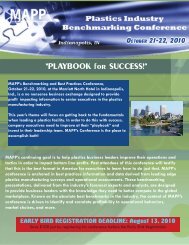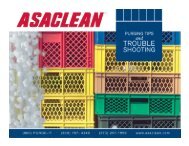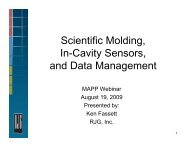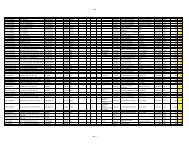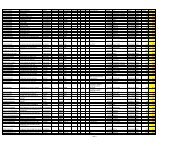Advantages of Understanding UL Requirements - MAPP
Advantages of Understanding UL Requirements - MAPP
Advantages of Understanding UL Requirements - MAPP
You also want an ePaper? Increase the reach of your titles
YUMPU automatically turns print PDFs into web optimized ePapers that Google loves.
AND<br />
Present:<br />
<strong>Advantages</strong> <strong>of</strong> <strong>Understanding</strong> <strong>UL</strong><br />
<strong>Requirements</strong>
Polymer Resources<br />
Quality and Technology Team<br />
Phil Juzwick<br />
Kevin Sheehan<br />
Don McBournie
What is <strong>UL</strong>?<br />
Underwriters Laboratories Inc. (<strong>UL</strong>) is an<br />
independent product safety certification organization.<br />
Established in 1894, the company has its<br />
headquarters in Northbrook, Illinois.<br />
<strong>UL</strong> develops standards and test procedures for<br />
products, materials, components, assemblies, tools and<br />
equipment, chiefly dealing with product safety.
<strong>UL</strong> Mission Statement<br />
(from www.ul.com)<br />
Their mission: Working for a safer world since 1894<br />
The following principles drive every decision made at <strong>UL</strong>:<br />
<br />
<br />
<br />
<br />
<br />
<br />
<br />
<br />
Promoting safe living and working environments by the application <strong>of</strong> safety science and hazardbased<br />
safety engineering<br />
Supporting the production and use <strong>of</strong> products which are physically and environmentally safe and to<br />
apply our efforts to prevent or reduce loss <strong>of</strong> life and property<br />
Advancing safety science through research and investigation<br />
Concentrating our efforts and resources on public safety in those areas where we can make valuable<br />
contributions<br />
Working with integrity and a focus on quality to enhance the trust conveyed by our certification<br />
marks and services<br />
Charging fair prices that allow us to meet our obligations, sustain our growth, and invest in safety<br />
science and education<br />
Investing in our people and encourage our people to invest in themselves<br />
Being a good example <strong>of</strong> corporate citizenship and social responsibility
<strong>UL</strong> Mission Statement<br />
(from www.ul.com)<br />
Global conformity<br />
<br />
<br />
<br />
<br />
<br />
<br />
<br />
<br />
<br />
<br />
<br />
20 billion <strong>UL</strong> Marks appeared on products<br />
66,149 manufacturers produced <strong>UL</strong> certified products<br />
84,994 product evaluations were conducted by <strong>UL</strong><br />
570,088 follow-up services inspection visits were conducted by <strong>UL</strong><br />
19,597 types <strong>of</strong> products were evaluated by <strong>UL</strong><br />
120 <strong>UL</strong> inspection centers in service<br />
102 countries with <strong>UL</strong> customers<br />
1.5 billion consumers were reached by <strong>UL</strong> with safety messages in Asia, Europe and North<br />
America<br />
1,420 current standards for safety published by the <strong>UL</strong> family <strong>of</strong> companies (1,122 for <strong>UL</strong>;<br />
298 for <strong>UL</strong>C)<br />
68 laboratory, testing and certification facilities in the <strong>UL</strong> family <strong>of</strong> companies<br />
6,921 employees in the <strong>UL</strong> family <strong>of</strong> companies ready to serve <strong>UL</strong> customers
<strong>UL</strong> Standards<br />
Electrical Enclosures<br />
Boxes-Junction and Pull (BGUZ)<br />
Cabinets and Cutout Boxes-Sheet Metal (CYIV)<br />
Industrial Control Panel Enclosures (NITW)<br />
Industrial Control Panels<br />
Industrial Control Panels (NITW)<br />
Flame Control Panels<br />
Power Press Control Panels<br />
High-Voltage Industrial Control Equipment<br />
Motor Controllers, Over 1500 V (NJHU)<br />
Motor Controller Accessories-Over 1500 V (NJIJ)<br />
Medium Voltage Power Conversion Equipment (NJIC)<br />
Power Conversion Equipment<br />
Power Conversion Equipment (NMMS)<br />
Locks for Safes<br />
Mechanical Dial Combination Locks<br />
(Group I and Group II)<br />
Electronic Locks<br />
Biometric Locks<br />
Industrial Control Equipment<br />
Auxiliary Devices (NKCR)<br />
Electromechanical<br />
Solid State<br />
Mechanical<br />
Electronic<br />
Combination Motor Controllers (NKJH)<br />
Float and Pressure-Operated Switches (NKPZ)<br />
Magnetic Motor Controllers (NLDX)<br />
Manual Motor Controllers (NLRV)<br />
Motor Controllers-Miscellaneous (NMFT)<br />
Miscellaneous Apparatus (NMTR)<br />
Switches, Industrial Control (NRNT)<br />
Programmable Controllers (NRAQ)<br />
Proximity Switches (NRKH)
Underwriters Laboratories<br />
<strong>UL</strong> 94 – Tests for Flammability <strong>of</strong> Plastic Materials for Parts in<br />
Devices and Appliances<br />
<strong>UL</strong> 746A – Short Term Property Evaluations<br />
<strong>UL</strong> 746B – Long Term Property Evaluations<br />
<strong>UL</strong> 746C – Use in Electrical Equipment Evaluations<br />
<strong>UL</strong> 746D – Fabricated Parts
<strong>UL</strong> 94<br />
Flammability <strong>of</strong> Plastic Materials for Parts in Devices and Appliances<br />
HB (Horizontal Burn, flame bar – 5”x 1/2”x tk)<br />
V-0, V-1, V-2 (Vertical Burn, flame bar)<br />
5-VA, 5-VB (Flame bars and 6”x6”x tk plaque)<br />
HF-1, HF-2, HBF (Foamed Materials, 5”x2”x tk)<br />
VTM-0, VTM-1, VTM-2 (Film or very thin)<br />
Other (Radiant, Steiner, and Small Component –<br />
specimens either too big or too small to use any other<br />
classification)
<strong>UL</strong> 94<br />
Flammability <strong>of</strong> Plastic Materials for Parts in Devices and Appliances
<strong>UL</strong> 94<br />
Flammability <strong>of</strong> Plastic Materials for Parts in Devices and Appliances
<strong>UL</strong> 94<br />
Flammability <strong>of</strong> Plastic Materials for Parts in Devices and Appliances<br />
Material Classifications<br />
Criteria V-0 V-1 V-2<br />
After burn time for each individual specimen t 1<br />
or t 2<br />
< 10 sec < 30 sec < 30 sec<br />
Total burn time for set <strong>of</strong> 5 specimens t 1<br />
+ t 2<br />
< 50 sec < 250 sec < 250 sec<br />
Second burn time + "after glow" time t 2<br />
+ t 3<br />
< 30 sec < 60 sec < 60 sec<br />
Burn Up to the holding clamp for any specimen? No No No<br />
Cotton ignited by flaming particles or drops? No No Yes
<strong>UL</strong> 94<br />
Flammability <strong>of</strong> Plastic Materials for Parts in Devices and Appliances<br />
5VA and 5VB<br />
5 applications <strong>of</strong> 125mm flame<br />
Both Vertical and Horizontal components<br />
5VA: Less than 60 seconds Vertical Burn, and no<br />
“Burn Through” with 6” x 6” plaque.<br />
5VB: Less than 60 seconds Vertical Burn, but “Burn<br />
through” with 6” x 6” plaque.
<strong>UL</strong> 746B<br />
Long Term Property Evaluations<br />
Relative Thermal Index (RTI)<br />
Provides an indication <strong>of</strong> the ability <strong>of</strong> a material to<br />
retain a property after exposure to an elevated<br />
temperature for an extended period <strong>of</strong> time.<br />
RTI ratings are given in Degrees C
Properties Relevant to RTI<br />
There are three critical properties associated with<br />
RTI<br />
RTI Electrical<br />
Associated with insulating properties<br />
RTI Mechanical Impact<br />
Associated with impact resistance, toughness, elongation and<br />
flexibility<br />
RTI Mechanical Strength<br />
Associated with mechanical strength or structural integrity
Example <strong>of</strong> RTI Listing<br />
Min Thk RTI RTI RTI<br />
Color (mm) Elec Imp Str<br />
(X) 1.5 125 110 125<br />
3.0 125 110 125<br />
<strong>UL</strong> determines the RTI requirements for<br />
a specific application.
Determination <strong>of</strong> RTI<br />
A thermal aging program assigns RTI based upon<br />
comparison with a material with an established RTI.<br />
(Approximately 1 year to complete)<br />
If a thermal aging program is not carried out, then a<br />
“Generic” RTI is assigned based upon the chemical<br />
structure <strong>of</strong> the material.
<strong>UL</strong> 746B<br />
Assignment <strong>of</strong> Generic RTI<br />
Generic Thermal Indices<br />
Material<br />
ISO Designation<br />
Generic Thermal Index<br />
(Deg C)<br />
Polyamide PA 65<br />
Polycarbonate PC 80<br />
PC PBT alloy PC PBT 75<br />
Acrylonitrile-Butadiene-<br />
Styrene<br />
ABS 60<br />
PC ABS alloy PC ABS 60<br />
Polybutylene<br />
terephthalate<br />
PBT 75<br />
Polyetherimide PEI 105<br />
Polyphenylene Oxide PPO 65<br />
All materials not listed for a generic thermal index will receive a 50C rating
<strong>UL</strong> 746C<br />
Use in Electrical Equipment Evaluations<br />
Electrical<br />
Electrical Insulation<br />
Enclosures<br />
Flammability<br />
Mechanical<br />
Permanence (weatherability – UV, f1 and f2)
<strong>UL</strong> f1 & f2<br />
Outdoor suitability<br />
<br />
<br />
<br />
A material that is considered suitable for outdoor use has gone<br />
through ultraviolet (UV) light exposure for 720 hours <strong>of</strong> twinenclosed<br />
carbon or 1,000 hours <strong>of</strong> xenon-arc weatherometer<br />
conditioning, and/or water exposure or immersion for the seven<br />
days at 70 degrees C. The material is tested before and after<br />
exposure for flammability, mechanical impact and mechanical<br />
strength.<br />
(f1) - indicates that the material has met both UV and water<br />
exposure or immersion requirements as called out in <strong>UL</strong> 746C.<br />
(f2) - indicates that the material has only met or has been tested<br />
partially for UV or water exposure or immersion. (the material did<br />
not perform well in either UV or water testing)
<strong>UL</strong> 746D<br />
Fabricated Parts<br />
This standard applies to parts that have been<br />
molded or fabricated from polymeric material<br />
Intent is to provide a quick verification <strong>of</strong> material<br />
ID by marking on the part<br />
The material ID program is intended to provide<br />
traceability
<strong>UL</strong> 746D<br />
Fabricated Parts<br />
Additives<br />
Colorants, FR’s, fillers, mold releases, color concentrates,<br />
blowing agents cannot be used unless first tested and<br />
verified<br />
Exceptions<br />
Mold release applied to the mold for V2 or better<br />
Blowing agents so that finished part retains 95% <strong>of</strong> weight<br />
Water based dyes to outside <strong>of</strong> part<br />
Dry blended color concentrates<br />
Dry blended FR
<strong>UL</strong><br />
Pre-selection Testing <strong>of</strong> Polymeric Materials<br />
Taking advantage <strong>of</strong> a valuable tool<br />
Pre-selection is a valuable tool for both product<br />
designers and component suppliers. Plastic materials<br />
that demonstrate an acceptable performance when<br />
subjected to the small-scale pre-selection tests should<br />
behave favorably when subjected to end product<br />
testing in the product application.<br />
The use <strong>of</strong> pre-selection test data can reduce the time<br />
and costs associated with final end product testing and,<br />
consequently, the time to market for end product and<br />
component manufacturers.
<strong>UL</strong><br />
Pre-selection Testing <strong>of</strong> Polymeric Materials<br />
Increase product speed to market<br />
Helps designers find materials that comply with<br />
safety standards<br />
IEC 60335-1 and IEC 60950-1 now permit the use<br />
<strong>of</strong> materials pre-selection testing as the equivalent<br />
or preferred method to end product testing on<br />
assembled plastic parts
<strong>UL</strong><br />
Pre-selection Testing <strong>of</strong> Polymeric Materials<br />
For example, a material’s resistance to ignition or flammability,<br />
as well as its electrical, tracking resistance,<br />
physical/mechanical and thermal characteristics, may be<br />
critical parameters for an appliance enclosure that is relied<br />
upon as electrical insulation.<br />
Pre-selection provides several advantages to product<br />
designers looking to determine such characteristics,<br />
including:<br />
An increased level <strong>of</strong> safety in the design <strong>of</strong> the end product<br />
Consistency <strong>of</strong> test data<br />
Reduced design costs<br />
Availability <strong>of</strong> material data
<strong>UL</strong><br />
Pre-selection Testing <strong>of</strong> Polymeric Materials<br />
<strong>UL</strong> iQ for Plastics contains information regarding the following materials preselection<br />
characteristics:<br />
Flammability<br />
Glow wire flammability and ignition<br />
Hot-wire ignition<br />
High-ampere ignition<br />
Dielectric breakdown strength<br />
Impact resistance<br />
Ball pressure<br />
Vicat s<strong>of</strong>tening and heat deflection<br />
Comparative tracking index<br />
Relative thermal indices<br />
Materials included in <strong>UL</strong> iQ for Plastics are covered under <strong>UL</strong>’s Component Recognition Program.
<strong>UL</strong> IQ
<strong>UL</strong> IQ
How to obtain a yellow card
Yellow Card<br />
Click on the<br />
hyperlink for<br />
“PC/ABS –FR1”
How <strong>UL</strong> IQ can help you<br />
Use <strong>UL</strong> IQ parametric to find an alternate material<br />
Then use the “company”, “grade”, or “tradename”<br />
search tools<br />
Obtain a yellow card<br />
Submit to your customer for approval
Websites<br />
<strong>UL</strong><br />
www.ul.com/plastics<br />
<strong>UL</strong> IQ<br />
iq.ul.com<br />
Polymer Resources<br />
www.prlresins.com<br />
Thank You!



